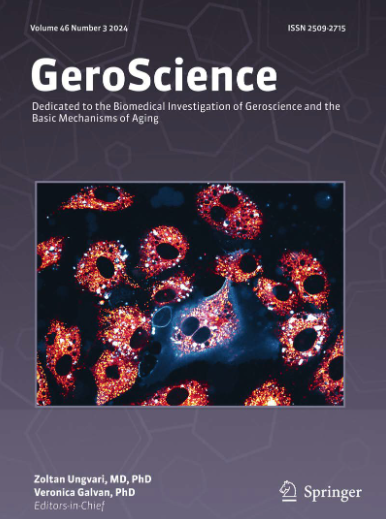加速表型衰老、生活方式和遗传风险与心脏代谢多病进展的关联:一种多状态模型分析。
IF 5.4
2区 医学
Q1 GERIATRICS & GERONTOLOGY
引用次数: 0
摘要
我们的目的是使用多状态模型来评估生活方式和遗传风险与表型年龄加速对心脏代谢多病(CMM)轨迹的联合影响,并进一步探讨表型年龄加速是否介导生活方式与每种转变之间的关联。我们进行了一项前瞻性队列研究,包括365,573名无心血管代谢疾病(cms)的成年人,基线在UK Biobank。采用多状态模型计算生活方式和遗传风险与PhenoAgeAccel共同影响CMM进展的风险比(hr)和95%置信区间(ci)。进行中介分析以探索PhenoAgeAccel对生活方式和所有转变之间的关联的间接影响。在中位13.68年的随访期间,54,483名参与者出现了首次心脏代谢疾病(FCMD), 7,397名参与者出现了CMM, 27,288名参与者死于任何原因。表型老化加速和不良生活方式的参与者有更高的所有转变风险,hr范围从1.53 (95% CI 1.37, 1.71)到2.80(2.62,3.00)。此外,表型老化加速和遗传风险高的人群发生口蹄疫的风险更高(HR 1.46; 95% CI 1.32, 1.61),从口蹄疫向CMM过渡的风险更高(2.09;2.02,2.17)。此外,表型年龄加速部分介导了生活方式对所有转变的影响,中介比例从6.28%(3.46,9.10%)到9.92%(6.37,13.46%)不等。表现型年龄加速的参与者有CMM进展的风险增加,特别是那些不良生活方式和高遗传风险的参与者。表型年龄加速部分介导了生活方式与CMM进展之间的关系。本文章由计算机程序翻译,如有差异,请以英文原文为准。
Association of accelerated phenotypic aging, lifestyle and genetic risk with progression of cardiometabolic multimorbidity: a multi-state model analysis.
We aimed to use multi-state models to assess joint impacts of lifestyle and genetic risk with phenotypic age acceleration on cardiometabolic multimorbidity (CMM) trajectory, and to further explore whether phenotypic age acceleration mediates association between lifestyle and each transitions. We conducted a prospective cohort study included 365,573 adults free of cardiometabolic diseases (CMDs) at baseline in UK Biobank. Multi-state model was used to calculate hazard ratios (HRs) and 95% confidence intervals (CIs) of joint impacts of lifestyle and genetic risk with PhenoAgeAccel on CMM progression. Mediation analyses were conducted to explore indirect effect of PhenoAgeAccel on association between lifestyle and all transitions. During a median follow-up of 13.68 years, 54,483 participants developed first cardiometabolic diseases (FCMD), 7,397 developed CMM, and 27,288 died from any causes. Participants with accelerated phenotypic aging and unfavorable lifestyles had higher risks of all transitions, with HRs ranging from 1.53 (95% CI 1.37, 1.71) to 2.80 (2.62, 3.00). Additionally, those with accelerated phenotypic aging and high genetic risk showed a higher risk of FCMD incidence (HR 1.46; 95% CI 1.32, 1.61) and transition from FCMD to CMM (2.09; 2.02, 2.17). Furthermore, phenotypic age acceleration partially mediated the impact of lifestyle on all transitions, with mediation proportion varying from 6.28% (3.46, 9.10%) to 9.92% (6.37, 13.46%). Participants with phenotypic age acceleration have increased risk of CMM progression, especially among those with unfavorable lifestyles and high genetic risk. Phenotypic age acceleration partially mediated the relationship between lifestyle and CMM progression.
求助全文
通过发布文献求助,成功后即可免费获取论文全文。
去求助
来源期刊

GeroScience
Medicine-Complementary and Alternative Medicine
CiteScore
10.50
自引率
5.40%
发文量
182
期刊介绍:
GeroScience is a bi-monthly, international, peer-reviewed journal that publishes articles related to research in the biology of aging and research on biomedical applications that impact aging. The scope of articles to be considered include evolutionary biology, biophysics, genetics, genomics, proteomics, molecular biology, cell biology, biochemistry, endocrinology, immunology, physiology, pharmacology, neuroscience, and psychology.
 求助内容:
求助内容: 应助结果提醒方式:
应助结果提醒方式:


